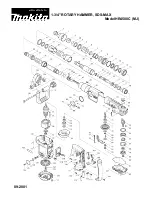
GB
- 21 -
d) Remove keys and wrenches before swit-
ching on the electric tool.
A tool or key
which comes into contact with rotating parts
of the appliance can lead to injuries.
e) Avoid abnormal working postures. Make
sure you stand squarely and keep your
balance at all times.
In this way, you can
control the electric tool better in unexpected
circumstances.
f) Wear suitable work clothes. Do not wear
loose clothing or jewellery. Keep hair, clo-
thes and gloves away from moving parts.
Loose clothing, jewellery or long hair can get
trapped in moving parts.
g) If vacuuming devices and draining de-
vices can be
fi
tted, make sure that these
are correctly attached and correctly used.
The use of a dust extraction system can redu-
ce the danger posed by dust.
Do not lose this safety information.
4. Usage and treatment of the electric tool
a) Do not overload the appliance. Use the
correct tool for your work.
You will be able
to work better and more safely within the gi-
ven performance boundaries.
b) Do not use an electric tool with a defec-
tive switch.
An electric tool that cannot be
switched on or o
ff
is dangerous and must be
repaired.
c) Pull the plug out of the socket and/or
remove the battery before making any ad-
justments to the appliance, changing ac-
cessories or put the appliance down.
This
safety measure prevents starting the electric
tool unintentionally.
d) Keep unused electric tools out of the
reach of children. Do not allow people
who are not familiar with the appliance or
who have not read these instructions to
use the appliance.
Electric tools are dange-
rous if they are used by inexperienced people.
e) Clean your electric tool carefully. Check
whether moving parts are functioning
properly and not jamming, whether parts
are broken or damaged enough that the
functioning of this electric tool is a
ff
ec-
ted. Have damaged parts repaired before
using the appliance.
Many accidents are
caused by badly maintained electric tools.
f) Keep your cutting tools sharp and clean.
Carefully maintained cutting tools with sharp
cutting edges will jam less and are easier to
control.
g) Make sure to use electric tools, accesso-
ries, attachments, etc. in accordance with
these instructions. Take the conditions in
your work area and the job in hand into
account.
Using electric tools for any purpose
other than the one for which they are intended
can lead to dangerous situations.
5. Service
a) Have your electric tool repaired only by
trained personnel using only genuine
spare parts
. This will ensure that your elec-
tric tool remains safe to use.
Do not lose these safety instructions
Safety Information for hammer
a) Wear ear protection.
The impact of noise
can cause damage to hearing.
b) Use the additional handles supplied with
the tool.
Losing control of the tool can cause
injuries.
c) Hold the equipment by the insulated
handles when carrying out work during
which the plug-in tool could strike con-
cealed power cables or its own mains
lead.
Contact with a live cable can also make
the metal parts of the equipment live and will
cause an electric shock.
This appliance is not intended for use by persons
(including children) with reduced physical, sen-
sory or mental capabilities, or lack of experience
and knowledge, unless they have been given
supervision or instruction concerning use of the
appliance by a person responsible for their safety.
Children should be supervised to ensure that they
do not play with the appliance.
Do not lose these safety instructions
2. Layout and items supplied
2.1 Layout (Fig. 1)
1. Handle
2. ON/OFF
switch
3. Additional
handle
4. Fastening for additional handle
5. Locking
bolt
6. Tool
chuck
7. Pointed
chisel
8. Flat
chisel
Anl_SA_TE_DH_50_SPK8.indb 21
Anl_SA_TE_DH_50_SPK8.indb 21
27.02.2019 11:28:00
27.02.2019 11:28:00
















































